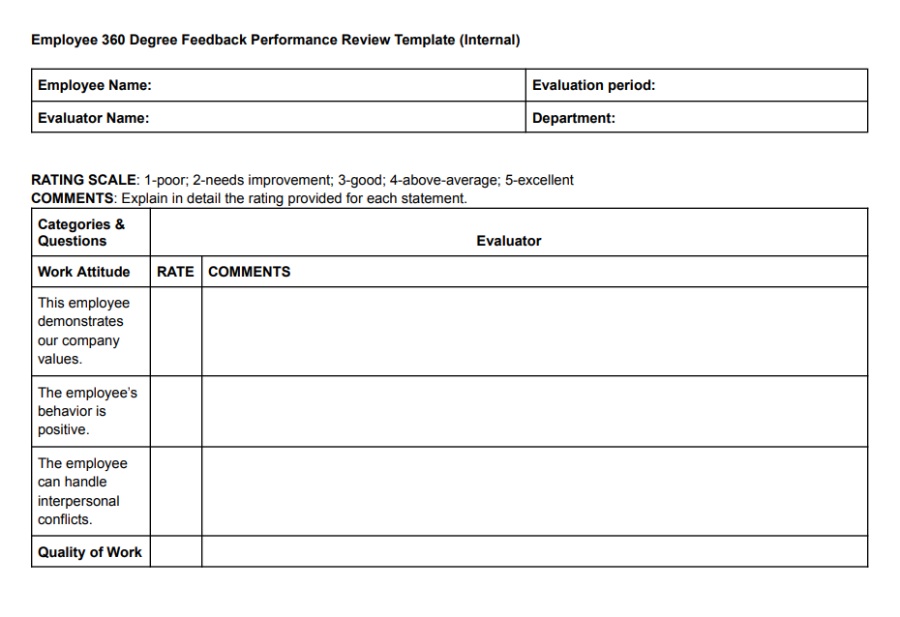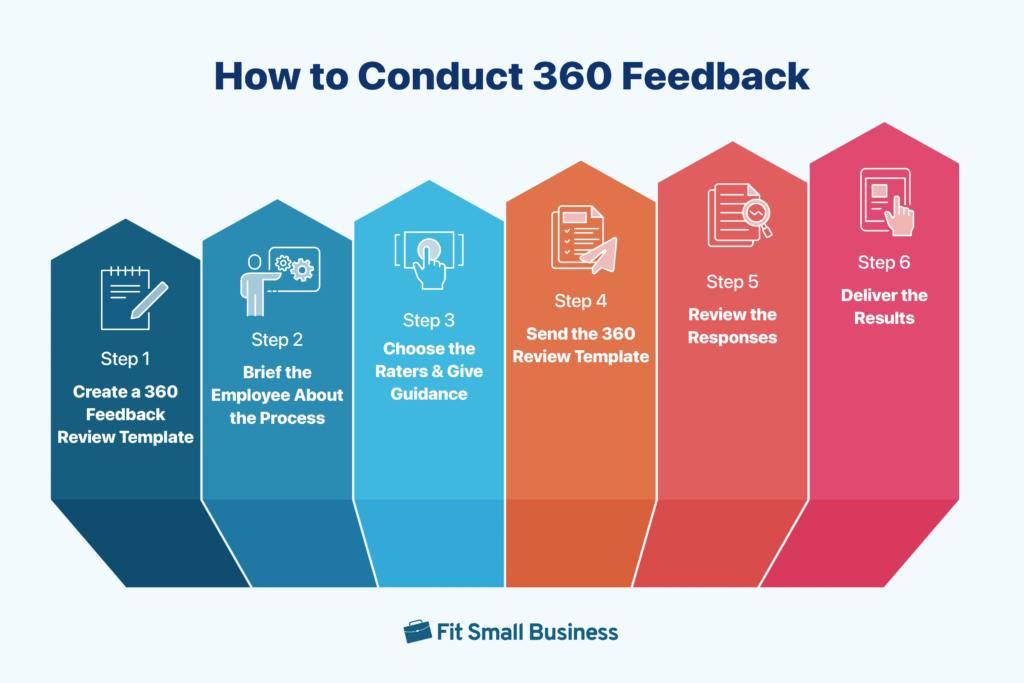360 feedback is a peer-to-peer feedback method that allows managers to view employees from the eyes of multiple reviewers. Learn the basics, how to conduct 360-degree reviews, and see how real companies put it into practice.
360 Feedback: Complete Guide + Free Review Template
Key Takeaways:
- 360-degree feedback collects performance reviews from multiple sources, such as managers, peers, and subordinates in order to see a full holistic view of an employee’s overall contributions.
- 360 feedback should be anonymous and should not replace a regular performance review conducted by a manager.
- To conduct 360-degree feedback, create a review template, choose your raters, send them the review, analyze the responses, and deliver the results to the employee.
Featured Partner

Thank you for downloading!
For assistance in creating and conducting your 360 feedback consider BambooHR. Try it free today!
What Is 360-degree Feedback
360 feedback (or 360-degree feedback) is a type of employee performance review in which an employee receives feedback not just from their direct supervisor but also from peers and, when applicable, direct reports, subordinates, and customers. Feedback is generally anonymous, and the number of raters varies (anywhere from three to 12) depending on the employee’s role and seniority.
360 feedback enables employees to see how they are performing through a holistic lens, providing a balanced view of performance that often uncovers behaviors (both positive and negative) that a supervisor alone may not be aware of.
360-degree Feedback vs Performance Review
A performance review is typically conducted by a manager only and involves an assessment of the employee’s performance against established goals and objectives. On the other hand, 360-degree feedback is a comprehensive evaluation of the employee’s overall performance from multiple perspectives, such as their manager, peers, and subordinates.
360-degree Feedback | Performance Review |
|---|---|
Evaluation to determine the employee’s strengths and areas for improvement | Evaluation based on goals and objectives |
Conducted by multiple reviewers, such as a manager, peer, or subordinate | Conducted by a manager |
Increases self-awareness and encourages employees to take ownership of their career growth | Opportunity to review compensation and advancement opportunities |
Encourages open communication, collaboration, and ongoing improvement | Avenue for evaluating past performance, strengths, and areas for improvement |
Basics of Implementing a 360 Feedback Process
Typical performance reviews only provide one perspective—the employee’s direct supervisor—whereas 360 feedback includes input from across the spectrum of an employee’s relationships. Every employee should receive 360 feedback. Not only will this help avoid accusations of discrimination, but it will also give accurate and timely information on how employees view each other.
Who Should Give 360 Feedback
With a 360 review process, you want genuine and productive feedback about the employee’s behavior and performance. The more senior an employee and the more workers they oversee, the more raters they should have. Entry-level positions only need two or three raters.
- Manager: Along with other peers, the employee’s manager or supervisor should participate in the 360 feedback process and evaluate the employee’s work performance and behaviors.
- Peers: I recommend that you include peer employees who may have had important interactions with the employee being reviewed during this review period.
- Clients: Though not required, some organizations (e.g., retail, real estate, or salons) like to include feedback from outside the company by soliciting help from vendors, clients, or customers. They can provide a unique perspective into how well the employee is performing.
- Subordinates: Getting the whole picture of the employee’s performance should include feedback from those who report to the employee (if applicable). This will give you insight into the type of leadership style the employee has.
- Employee: The employee should provide a self-evaluation. This will help you determine how the employee sees their performance in comparison or contrast to how their peers see it.
Why 360 Feedback Should Be Anonymous
Feedback from managers does not have to be anonymous, as managers should be able to have direct conversations with all of their employees. However, to get honest and transparent information, all other feedback (except the employee’s self-evaluation) should be anonymous.
An anonymous process reduces stress on the raters, puts the focus on the feedback and not the source, and helps avoid workplace conflict.
When to Give 360 Feedback
I recommend doing a 360 review annually. However, you can also give 360 feedback after completing a major project, as needed to encourage an employee’s development, or on a more frequent basis (such as quarterly).
Note that a 360 performance review should not take the place of or be combined with a regular performance review. It also shouldn’t take the place of real-time feedback; it should simply be a part of your broader performance management process, along with other types of feedback.
How to Conduct 360 Feedback
As a manager, you need to ensure you get accurate data on your employees. Following a structured process like the one outlined below will help you get honest feedback from your team members.

Steps to conduct 360 feedback. (Source: FSB)
Step 1: Create a 360 Feedback Review Template
Keep in mind, when creating your template, that 360 feedback should be open-ended. So, your questions/comments should allow the raters to expand on their answers. I also recommend including a five-point rating system—just make sure that raters know to provide written details to answer each category for a clearer picture.
Here are some statements you might want to include for managers and coworkers (for internal review), customers or vendors (for external review), and employees (self-evaluation). You can also download our free 360-degree feedback template shown above, which includes all of the below prompts.
Step 2: Brief the Employee About the Process
Many employees haven’t participated in 360 feedback before. While learning about it should ideally be part of your company’s onboarding process, it’s not a bad idea to remind them of how it works.
Discuss the process, what information you’ll solicit from others, and when you expect to meet with them again to review the results. Keeping your employees informed will ease their concerns about what’s happening behind closed doors.
Step 3: Choose the Raters & Give Guidance
360 feedback should involve managers, colleagues, and even clients. If you can, choose raters that the employee worked with on a recent big project.
When you assign raters, give them a timeline. It’s important to provide a reasonable amount of time to complete the feedback as it can get time-consuming, particularly if they’re rating multiple employees. Generally, a deadline of two to four weeks is good.
Also, raters should be given guidelines for completing review forms, which can include open-text questions and ratings. Ideally, these forms should be used for every review. Remind raters to keep comments focused on work-related actions.
If you’re asking raters to give their colleagues a score of one to five, make sure they have an understanding of what each numerical value represents. Encourage raters to give positives and negatives in their comments—at least one each, preferably three. This helps you get accurate and honest feedback on employee performance.
Step 4: Send the 360 Review Template
When sending the 360 feedback template to raters, you can either print them out and hand them to the reviewer or send an individual link to the rater and have them complete their portion online. Then once all reviews are submitted back to you, you will compile the feedback together into one document.
Step 5: Review the Responses
As a manager, this is where you step back in to review all of the comments and scores (if you used any) before sharing them with the employee. You may also want to request additional information if something is unclear.
Putting the data together into one report for the employee to review is not recommended for two reasons:
- First, it defeats the purpose of having anonymous reviews if the manager is going to paraphrase all of them.
- Second, the manager may have a bias that comes through in the paraphrased comments, even unknowingly, which can affect how the comments are received.
Remember that anonymous feedback also opens up opportunities for rude and unprofessional comments. In case some responses may be too blunt, managers may have to step in to paraphrase them or omit them entirely. Ultimately, managers should use their judgment when reviewing the results with the employee.
Step 6: Deliver the Results
Up to this point, most of your work has been automated or electronic. Delivering the results of the 360 feedback should be personal, whether that’s in person or via video call (for remote employees).
Make sure that you know how to approach concerns the employee might have before going through the results with the employee. It’s not always easy to share negative feedback, but it’s crucial for the employee’s development.
Also, share positive feedback. Too often, an employee fails to recognize their contributions to the team. When they hear from their manager about the things they’ve done well, it can boost their morale and remind them that they may have very few areas that need improvement.
Pros and Cons of 360 Feedback
Soliciting feedback is an effective employee management tool. Feedback from multiple sources gives managers a balanced view of the employee being rated and helps them identify areas where they can offer better support to help the employee grow. However, it can also have some negatives, such as biased reviews and strain on your company culture.
Click the tabs below to learn more about the pros and cons of 360-degree feedback.
Real-life Successes of Implementing 360-degree Feedback
The following companies have had incredible success with 30-degree feedback. Click through the tabs below to learn how each increased engagement rates and improved overall retention.
360 Feedback Frequently Asked Questions (FAQs)
360 feedback can provide you with valuable insight into how others—managers, coworkers, and clients—view the performance and attitude of the employee. Each offers a different perspective, and while that can also be a negative, it can also give you a 360 view of how well the employee is doing.
Accuracy is an issue with 360-degree feedback because individual evaluators may have different recollections of how the employee performed. Additionally, depending on the evaluation and the criticism it may contain, this type of evaluation can lead to decreased motivation.
There are different methods to receive 360 feedback. These include:
- Surveys
- 360 Feedback Software
- Evaluation Forms
- Questionnaires
Yes. It is important to keep this process confidential and separate from a performance evaluation to safeguard the employee’s personal information. The only people who should have access to the 360 feedback documents are those directly involved with the feedback process.



